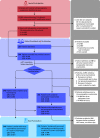Utility of a Deep-Learning Algorithm to Guide Novices to Acquire Echocardiograms for Limited Diagnostic Use
- PMID: 33599681
- PMCID: PMC8204203
- DOI: 10.1001/jamacardio.2021.0185
Utility of a Deep-Learning Algorithm to Guide Novices to Acquire Echocardiograms for Limited Diagnostic Use
Abstract
Importance: Artificial intelligence (AI) has been applied to analysis of medical imaging in recent years, but AI to guide the acquisition of ultrasonography images is a novel area of investigation. A novel deep-learning (DL) algorithm, trained on more than 5 million examples of the outcome of ultrasonographic probe movement on image quality, can provide real-time prescriptive guidance for novice operators to obtain limited diagnostic transthoracic echocardiographic images.
Objective: To test whether novice users could obtain 10-view transthoracic echocardiographic studies of diagnostic quality using this DL-based software.
Design, setting, and participants: This prospective, multicenter diagnostic study was conducted in 2 academic hospitals. A cohort of 8 nurses who had not previously conducted echocardiograms was recruited and trained with AI. Each nurse scanned 30 patients aged at least 18 years who were scheduled to undergo a clinically indicated echocardiogram at Northwestern Memorial Hospital or Minneapolis Heart Institute between March and May 2019. These scans were compared with those of sonographers using the same echocardiographic hardware but without AI guidance.
Interventions: Each patient underwent paired limited echocardiograms: one from a nurse without prior echocardiography experience using the DL algorithm and the other from a sonographer without the DL algorithm. Five level 3-trained echocardiographers independently and blindly evaluated each acquisition.
Main outcomes and measures: Four primary end points were sequentially assessed: qualitative judgement about left ventricular size and function, right ventricular size, and the presence of a pericardial effusion. Secondary end points included 6 other clinical parameters and comparison of scans by nurses vs sonographers.
Results: A total of 240 patients (mean [SD] age, 61 [16] years old; 139 men [57.9%]; 79 [32.9%] with body mass indexes >30) completed the study. Eight nurses each scanned 30 patients using the DL algorithm, producing studies judged to be of diagnostic quality for left ventricular size, function, and pericardial effusion in 237 of 240 cases (98.8%) and right ventricular size in 222 of 240 cases (92.5%). For the secondary end points, nurse and sonographer scans were not significantly different for most parameters.
Conclusions and relevance: This DL algorithm allows novices without experience in ultrasonography to obtain diagnostic transthoracic echocardiographic studies for evaluation of left ventricular size and function, right ventricular size, and presence of a nontrivial pericardial effusion, expanding the reach of echocardiography to clinical settings in which immediate interrogation of anatomy and cardiac function is needed and settings with limited resources.
Conflict of interest statement
Figures


References
Publication types
MeSH terms
Grants and funding
LinkOut - more resources
Full Text Sources
Other Literature Sources
Medical

